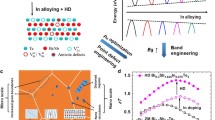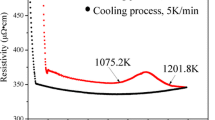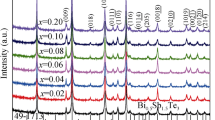Abstract
(BiSb)2Te3-based alloy is one of the best p-type thermoelectric (TE) materials near room temperature. However, it is challenging to improve its ZT value due to the interrelated Seebeck coefficient (S), electrical conductivity (σ), and thermal conductivity (κ). In this study, the synergistic optimization of S, σ, and κ has been easily achieved in Bi0.4Sb1.6Te3 alloy by liquid-state manipulation (LSM). Specifically, more Te-rich eutectic strips are observed in the LSM sample, which would increase carrier density (p) and thus improve σ. Meanwhile, via LSM, the raised effective mass m* could compensate the effect of increased p on S and thus an enhanced S is obtained. Furthermore, the larger amount of nanoparticles, higher density of lattice distortions, and dislocations in the LSM sample would contribute to scattering phonons and a lower κ is attained. As a result, the highest ZT of 0.7 at 352 K is attained which is 40% higher than that of traditional melted Bi0.4Sb1.6Te3 alloy.






Similar content being viewed by others
References
Liu W et al (2015) Current progress and future challenges in thermoelectric power generation: from materials to devices. Acta Mater 87:357–376
Sootsman JR et al (2009) New and old concepts in thermoelectric materials. Angew Chem Int Ed Engl 48:8616–8639
Chen G et al (2013) Recent developments in thermoelectric materials. Int Mater Rev 48:45–66
Hu L et al (2015) Tuning multiscale microstructures to enhance thermoelectric performance of n-type Bismuth–Telluride-based solid solutions. Adv Energy Mater 5:1500411–1500423
Zheng G et al (2016) Toward high-thermoelectric-performance large-size nanostructured BiSbTe alloys via optimization of sintering-temperature distribution. Adv Energy Mater 6:1600595–1600607
Suh J et al (2015) Simultaneous enhancement of electrical conductivity and thermopower of Bi(2)Te(3) by multifunctionality of native defects. Adv Mater 27:3681–3686
Keawprak N et al (2011) Thermoelectric properties of Bi2SexTe3−x prepared by Bridgman method. J Alloys Compd 509:9296–9301
He HF et al (2014) Interplay between point defects and thermal conductivity of chemically synthesized Bi2Te3 nanocrystals studied by positron annihilation. J Phys Chem C 118:22389–22394
Yu Y et al (2017) Simultaneous optimization of electrical and thermal transport properties of Bi 0.5 Sb 1.5 Te 3 thermoelectric alloy by twin boundary engineering. Nano Energy 37:203–213
Bin Z et al (2017) Attaining ultrahigh thermoelectric performance of direction-solidified bulk n-type Bi2Te2.4Se0.6 via its liquid state treatment. Nano Energy 42:8–16
Hwang C-W et al (2001) Effects of excess Te on the thermoelectric properties of p-type 25% Bi2Te3-75% Sb2Te3 single crystal and hot-pressed sinter. J Mater Sci 36:3291–3297. https://doi.org/10.1023/A:1017959008268
Hyun D-B et al (2001) Effect of excess Te addition on the thermoelectric properties of the 20% Bi 2 Te 3-80% Sb 2 Te 3 single crystal and hot-pressed alloy. Scr Mater 44:455–460
Yuan Y et al (2017) Dependence of solidification for Bi2Te3−xSex alloys on their liquid states. Sci Rep 7:2463–2472
Villars P et al (1995) Handbook of ternary alloy phase diagrams. Asm Intl, Russell Township
Yu Y et al (2015) Enhancing the thermoelectric performance of free solidified p-type Bi0.5Sb1.5Te3 alloy by manipulating its parent liquid state. Intermetallics 66:40–47
Yu Y et al (2015) Influence of melt overheating treatment on solidification behavior of BiTe-based alloys at different cooling rates. Mater Des 88:743–750
Li P et al (2002) Effect of melt overheating, cooling and solidification rates on Al–16 wt.% Si alloy structure. Mater Sci Eng A 332:371–374
Qiu D et al (2007) A novel approach to the mechanism for the grain refining effect of melt superheating of Mg–Al alloys. Acta Mater 55:1863–1871
Koh HJ et al (1995) The effect of various thermal treatments on supercooling of PbTe melts. Mater Sci Eng B 34:199–203
Zhu B et al (2017) Enhanced thermoelectric properties of n-type Bi2Te2.7Se0.3 semiconductor by manipulating its parent liquid state. J Mater Sci 52:8526–8537. https://doi.org/10.1007/s10853-017-1063-0
Zhu B et al (2018) Enhanced thermoelectric properties of n-type direction solidified Bi 2 Te 2.7 Se 0.3 alloys by manipulating its liquid state. Scr Mater 146:192–195
Hafner J et al (1984) Low-temperature electrical resistivity of amorphous Ca–Mg alloys. J Phys F Met Phys 14:1685–1691
Lotgering FK (1959) Topotactical reactions with ferrimagnetic oxides having hexagonal crystal structures—I. J Inorg Nucl Chem 9:113–123
Xiao Y et al (2014) Enhanced thermoelectric and mechanical performance of polycrystalline p-type Bi0.5Sb1.5Te3 by a traditional physical metallurgical strategy. Intermetallics 50:20–27
Ichikawa R et al (1971) Effects of cooling rate and supercooling degree on solidified structures of Al–Mn, Al–Cr and Al–Zr alloys in rapid solidification. Mater Trans JIM 12:280–284
Cruz H et al (2006) Quantification of the microconstituents formed during solidification by the Newton thermal analysis method. J Mater Process Technol 178:128–134
Turnbull D (1950) Formation of crystal nuclei in liquid metals. J Appl Phys 21:1022–1028
Poole PH et al (1997) Polymorphic phase transitions in liquids and glasses. Science 275:322–323
Hu L et al (2014) Point defect engineering of high-performance Bismuth–Telluride-based thermoelectric materials. Adv Funct Mater 24:5211–5218
Heremans JP et al (2008) Enhancement of thermoelectric efficiency in PbTe by distortion of the electronic density of states. Science 321:554–557
Li J et al (2013) BiSbTe-based nanocomposites with high ZT: the effect of SiC nanodispersion on thermoelectric properties. Adv Funct Mater 23:4317–4323
Wang S et al (2016) High thermoelectric performance in Te-free (Bi, Sb)2Se3via structural transition induced band convergence and chemical bond softening. Energy Environ Sci 9:3436–3447
Hu LP et al (2015) Enhanced figure of merit in antimony telluride thermoelectric materials by In–Ag co-alloying for mid-temperature power generation. Acta Mater 85:270–278
Acknowledgements
This work was supported by the National Natural Science Foundation of China (Grant No. 51371073) and by the National Key Basic Research Program of China (2012CB825702).
Author information
Authors and Affiliations
Corresponding author
Ethics declarations
Conflict of interest
I would like to declare on behalf of my co-authors that the work described was original research that has not been published previously, and not under consideration for publication elsewhere, in whole or in part. All the authors listed have approved the manuscript that is enclosed and declared that they have no conflict of interest.
Electronic supplementary material
Below is the link to the electronic supplementary material.
Rights and permissions
About this article
Cite this article
Gao, N., Zhu, B., Wang, Xy. et al. Simultaneous optimization of Seebeck, electrical and thermal conductivity in free-solidified Bi0.4Sb1.6Te3 alloy via liquid-state manipulation. J Mater Sci 53, 9107–9116 (2018). https://doi.org/10.1007/s10853-018-2209-4
Received:
Accepted:
Published:
Issue Date:
DOI: https://doi.org/10.1007/s10853-018-2209-4




